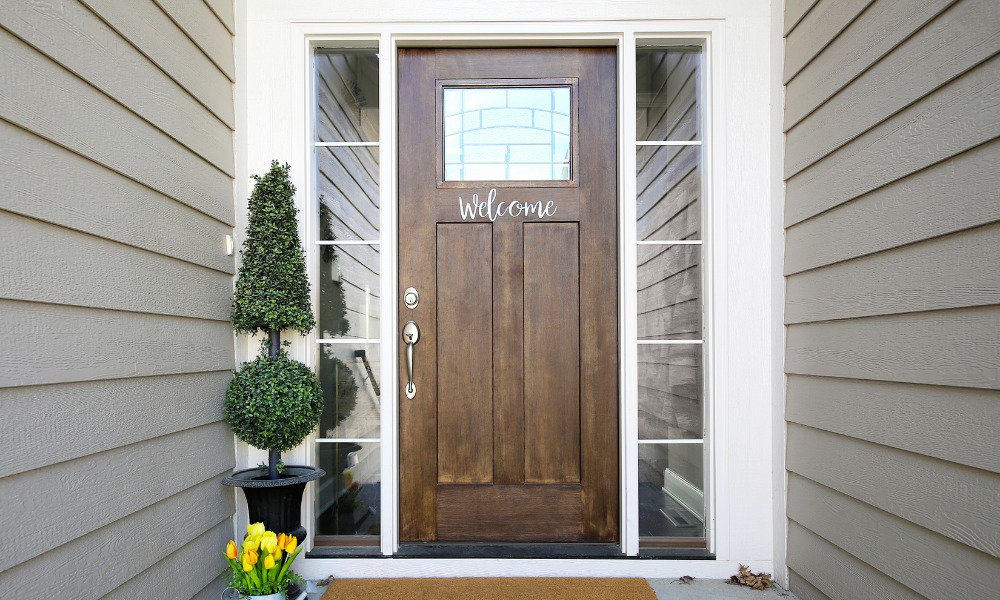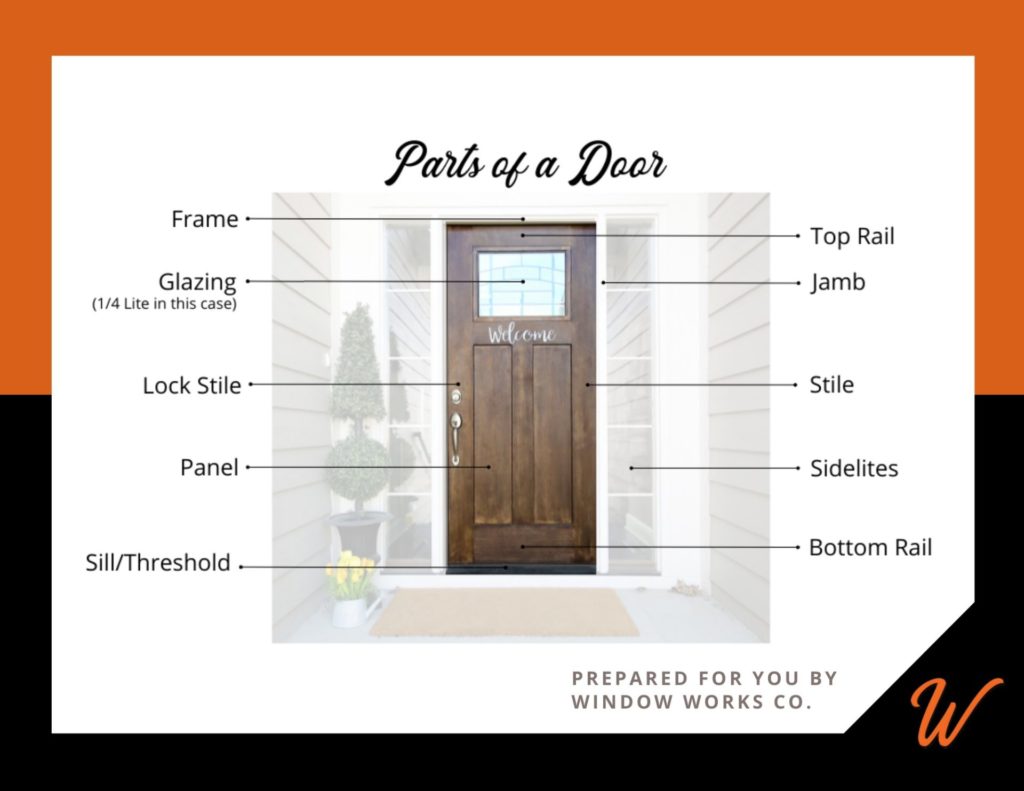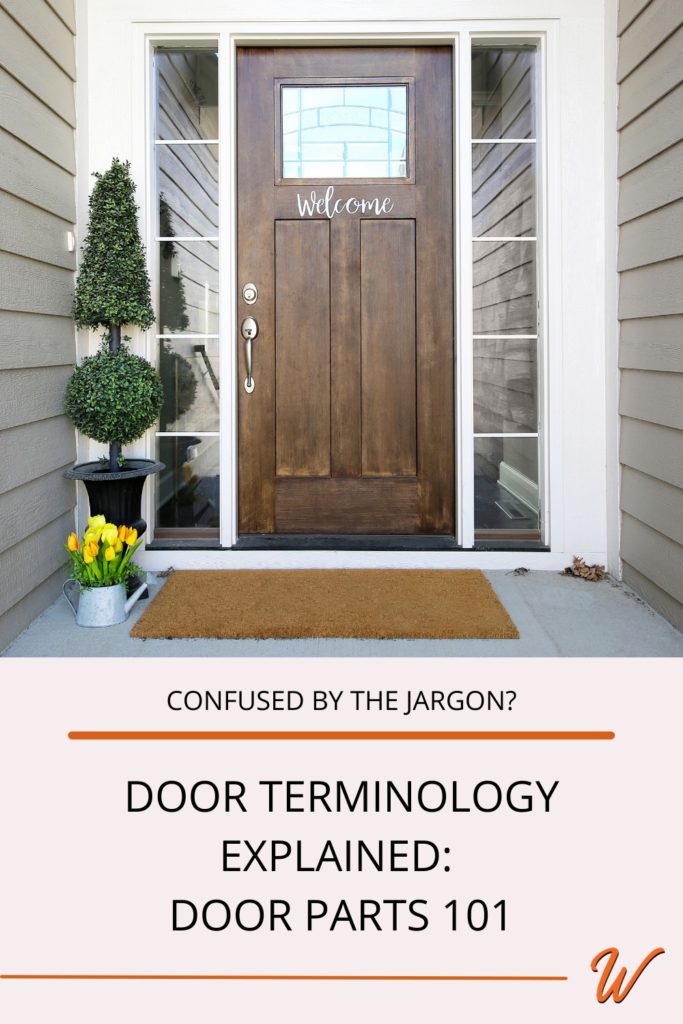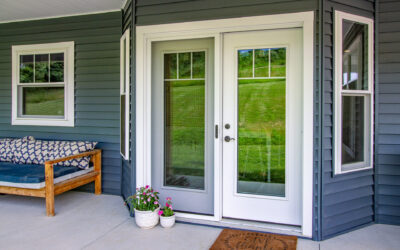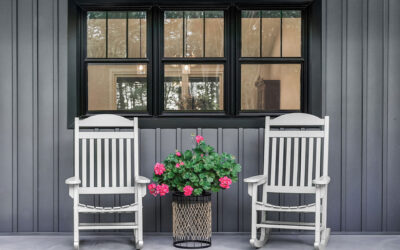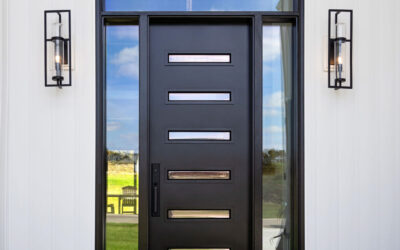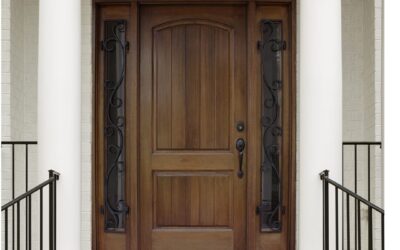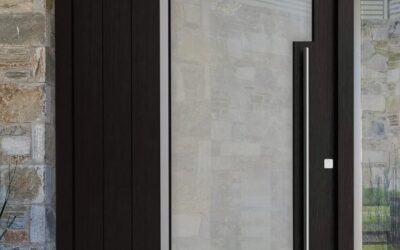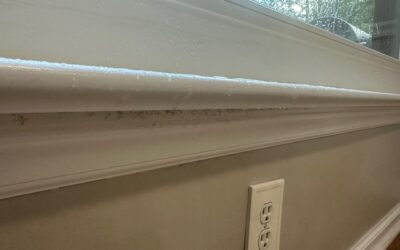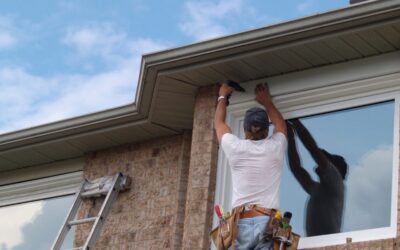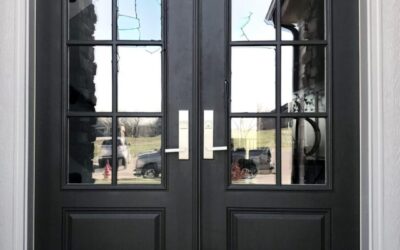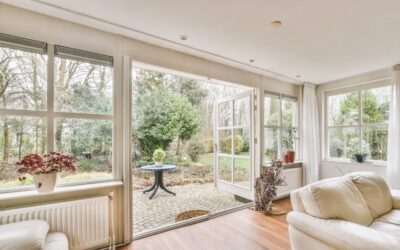Quite simply, this article contains every bit of jargon that you might ever hear while buying a new door.
Does the average homeowner need to know and understand every term in this list to buy a new door they love?
Absolutely not.
If you just want a quick reference sheet of the top terms to know, we’ve got you covered.
Click the image below to download our free printable of the Door Parts You Need to Know.
But, if you really want to know Astragals from your Escutchion plates, then read on!
#
- ¼ Lite: A door in which up to ¼ of the door panel is glass.
- ½ Lite: A door in which up to ½ of the door panel is glass.
- ¾ Lite: A door in which up to ¾ of the door panel is glass.
A
- Active: In a set of double doors, the door operates by using the handle set. The other door may be Stationary or Passive, or may also be Active. Synonym for Operable.
- Astragal: On a Double Door, the hardware between the two doors creates an airtight seal to prevent wind, water, and other elements from entering between the doors.
B
- Backset: The distance from the edge of the door to the center of the Bore Hole. This number is needed to ensure that you order Latches that are the correct length.
- Bifold Door: Two or more door panels hinged together so that, as they slide open, they easily “fold” or stack together against the door frame.
- Bore Hole/Boring: Pre-drilled hole or holes that allow your Handleset to be installed in a door.
- Bottom Rail: The horizontal rail at the bottom of the door. Sweeps over the sill.
- Brickmould: Exterior trim that is typically used to finish and seal the openings of exterior doors and provide a beautiful transition between the door and the siding on the home.
C
- Casing: A decorative trim around the outside of the door (around the Frame). Alternate name for Moulding.
- Center Stile: A vertical piece in the center of the Door Slab that adjoins Panels. A Door may not have a Center Stile.
- Closer: Hardware that is used to close a door either mechanically or automatically. Usually only seen in commercial buildings, but may be used in residential projects.
- Concealed Hinge: A type of Hinge that lays flush within a door to hide the Hinge.
- Concertina Door: Alternate name for a Bifold Door.
- Cross Rail: A horizontal bar below the Top Rail. Not all doors have a Cross Rail. An alternate name for a Frieze Rail.
D
- Deadbolt: A locking mechanism that can only be opened by a key or a handle (unlike a Spring Bolt Lock).
- Dentil Shelf: A decorative feature in the Craftsman style that is installed directly under the Top Panel or Glazing of a door. Not all doors have a Dentil Shelf.
- Double Bore: A door that has two Bore Holes.
- Double Door: A unit that is made of two doors. The doors may be Hinged or Gliding/Sliding.
- Dutch Door: A door divided into two parts horizontally, allowing one half to be shut and the other to remain open.
E
- Entry Door: A front door.
- Escutcheon Plate: A plate of metal that overlays and protects the keyhole.
- Exterior Door: Any door that opens to the exterior of the home. Entry Doors and Patio Doors are both types of Exterior Doors. Interior Doors, which open to rooms within the home, are not Exterior doors.
F
- Frame: The framework that supports the Door Slab. It includes Side Jambs, Head Jambs, and Sill.
- Freeze Rail: A horizontal bar below the Top Rail. Not all doors have a Frieze Rail. An alternate name for a Cross Rail.
- French Door: Technically may be one door, but is usually a pair of doors, with an Outward swing and Full Lite.
- Full Lite: A door in which more than ¾ of the panel is glass.
G
- Glazing: Any glass in the door panel.
- Gliding Door: A door that opens and closes by sliding sideways instead of swinging on Hinges.
H
- Handing: The way a door swings open. To determine the handling, stand on the side of the door that a key would be required to open it. Then use the guidance below to determine the door’s handing.
- Left Hand Door Swing (LH) – Hinges on the left stile of the door panel and as we push the door open it swings in.
- Right-Hand Door Swing (RH) – Hinges on the right style of the door panel and as we push the door open it swings in.
- Head Jamb: The top, horizontal piece of the Door Frame.
- Hinge: The jointed hardware that allows the door panel to move away from the frame. There are different types of door hinges.
- Hinge Stile: The vertical piece of a door that the Hinges are fixed to.
I
- In-swing: A door that swings (opens) into the room when opened.
J
- Jamb: Part of the Door Frame. The Jamb is the flat surface that runs vertically up either side of the door frame.
K
- Kickplate: A metal plate installed along the base of a door slab to protect it from damage during use.
- Knob: A round mechanism used to open and close the door.
L
- Latch: The mechanical hardware that keeps a door closed when it is shut.
- Level: A line or plane that is a set distance from a grounding feature. For instance, the top of your door should be Level to the floor below. This is measured by a device such as a carpenter’s level (see Plumb, Level, and Square).
- Lever Handle: A door opener that uses a handle to cause a door to Latch and unlatch.
- Lintel: Beam that spans above the Rough Opening for a doorway. May be visible or concealed within the wall.
- Lock Rail: A horizontal piece of a door that contains the Lock.
- Lock Stile: A vertical piece of a door that contains the Lock.
- Lock-set: A complete lock system including the lock mechanism together with Knobs, Keys, Plates, Strikes, and other accessories
M
- Mortise lock: A lock which is set within the body of a door in a recess (mortise), as opposed to being to the door surface.
- Moulding: A decorative trim around the outside of the door (around the Frame). An alternate name for Casing.
- Multi-point Lock System: Door Locking hardware that includes 3 bolts that secure the door in 3 separate places.
O
- Operable: Within a Double Door, the door operates by using the handle set. The other door may be Stationary or Passive, or may also be Operable. An alternate name for Active.
- Out-swing: A door that swings (opens) outward from a room when opened.
P
- Panel: Pieces of a Door Slab that is set between the Stiles, Rails, and Mullions.
- Passive Door: Within a Double Door, the door that is typically not used. It remains closed and fixed by bolts at the top and bottom but can be opened when desired. This is in contrast to a Stationary Door, which can not be opened.
- Patio Door: An Exterior Door off the side or back of a house, not an Entry Door.
- Plumb: A door that is Plumb will be perfectly vertical. Plumb may be best thought of as the vertical equivalent of Level for horizontal surfaces. (see Plumb, Level, and Square)
- Plumb, Level, and Square: To operate functionally, a properly installed door must be Plumb, Level, and Square. If it is not all three, then it will ultimately stop operating properly.
- Pre-hung: A Door Slab that is sold already attached by Hinges to a three-sided Door Frame.
R
- Racked: A Door that is Racked is not Plumb, and is not in alignment with its frame.
- Rail: The horizontal pieces of a door, which, along with the Stiles, hold the panels of the door. Not all Doors have Rails.
- RO: Acronym for Rough Opening.
- Rollers: Wheels that allow Sliding Doors to operate.
- Rough Opening: The size of the area that must be cut in the wall, measured in width x height, to allow the Door and Frame to be installed.
S
- SHGC: Solar Heat Gain Coefficient, a component of a Door’s Energy rating. Solar heat gain coefficient (SHGC) is a measure of heat gain inside your home from the sun. The lower a door’s SHGC, the less solar heat it allows into your home. A door with a high SHGC rating is more effective at collecting solar heat during the winter.
- Side Jamb: The two vertical pieces of the Door Frame.
- Sidelite: A narrow, vertical window that flanks an Entry Door. Usually, these are paired, though it is possible to have only one Sidelite next to an Entry Door.
- Sill: The bottom portion of the door frame that a person steps on when passing through the door. Alternate name for Threshold.
- Single Bore: Refers to a Door having only one Bore Hole, as is common in Interior Doors.
- Slab: The Door without any hardware, Framing, or Moulding attached.
- Sliding Door: A door that opens horizontally, usually parallel to a wall, by sliding on a track.
- Sliding Track: The system that allows a Sliding Door to open horizontally.
- Square: A door that is in the square will have 90° corners around the Frame and Moulding (see Plumb, Level, and Square).
- Stationary Door: Within a Double Door, a Door that matches the Operable Door in looks, but is itself not operable. This is in contrast to a Passive Door, which can be opened if desired.
- Stile: The vertical pieces of a door, which, along with Rails, hold the panels of the door. Not all Doors have Stiles.
- Storm Door: A second door installed outside of an Exterior door. Storm Doors are usually Full Lite, and offer protection against bad weather. They may also include a changeable screen to allow ventilation in fair weather.
- Strike plate: A metal plate in the Side Jamb that is cut to catch the Latch when the door is closed.
- Sweep: Weatherstripping that is affixed under the Bottom Rail of a door.
T
- Threshold: The bottom portion of the door frame that a person steps on when passing through the door. An alternate name for Sill.
- Transom: A stationary piece of glass (window) placed above an Entry Door and its Sidelites.
- Trim: The Casing or Moulding used around a Door Frame to conceal the crack or joint between the Frame and the wall. May also be used for decorative effects.
U
- U-Factor: Component of a Door’s Energy rating. The rate at which a door allows heat from inside the home to escape outside. The lower the U-factor, the more energy-efficient the door.
V
- Veneer: A thin piece of hardwood placed over a manufactured wood door to give it the look of a hardwood door.
- Visible Transmittance: Component of a Door’s Energy rating. Visible transmittance (VT) refers to the natural light (but not heat) that a door’s glass components allow to enter your home .The higher the number, the more light will come through the door.
W
- Weatherstripping: A narrow strip of metal or rubber placed between a Door Sash and a Door Frame to ensure an airtight seal when the Door is closed.
Dependable Door Installation Company in Cary, NC, and Surrounding Areas
Don’t forget where you found this helpful resource! Pin the image below to come back anytime you need to look up some door lingo!
When you’re ready to find the new doors you’ll love, you want to work with the pros at Window Works Co. who can help you learn everything you need to know to make the best choice.
Schedule your door consultation call today.
We can’t wait to help you find the doors you’ll love.

